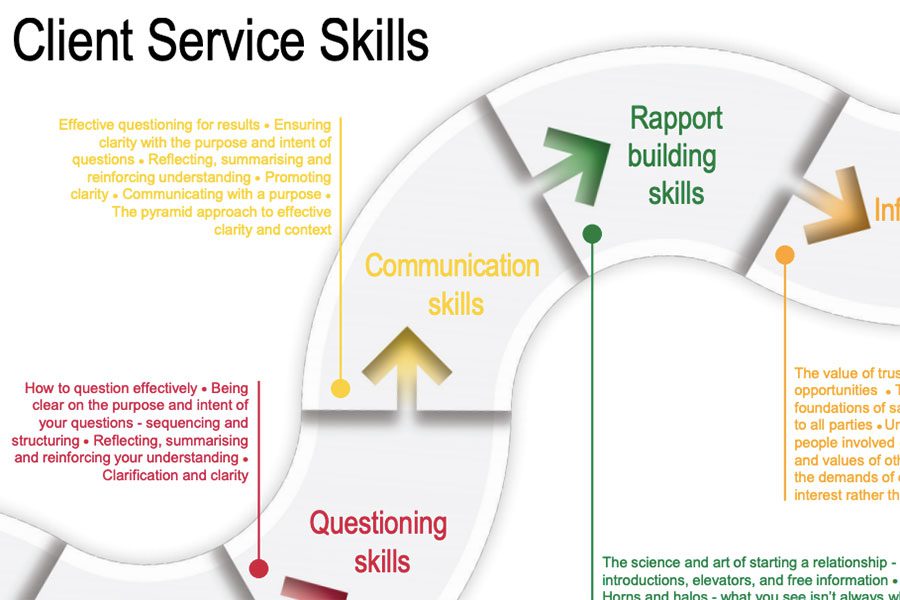Without regular, practical client service skills training, a company runs the risk of failing to understand the immediate and long term needs of its customers, which in turn can lead to losing valuable business opportunities.
As 67% of people worldwide believe that customer and client service is improving, it is now more important than ever to ensure that it is prioritised in the workplace.
At MDA Training, we believe that client service skills training is crucial to success in any professional industry. Our workplace training programmes provide employees with practical learning takeaways to apply immediately back in the workplace.
We’ve put together five core skills that employees can work on in order to improve their client service skills:
1 Listening skills
Relationships will ultimately break down if people feel that they aren’t being listened to or appreciated. Things like excessive talking, interrupting and misunderstanding all serve as barriers to listening and understanding the needs of your clients.
When it comes to developing listening skills as part of a wider client service skills training course in the workplace, both in-person and on virtual calls and meetings, employees should consider the following:
- How to listen effectively
- The habits of an effective listener
- The four-level listening model
- What stops us listening?
- Barriers to effective listening.
2 Questioning skills
Asking insightful and relevant questions can help you to understand more about the business needs of your clients, as well as how best to serve them. Ensuring that you have full clarity over what your client is looking for will help to sustain long term working relationships.
Things to consider when looking to improve questioning skills include:
- How to question effectively
- Being clear on the purpose and intent of your questions
- Reflecting, summarising and reinforcing your understanding
- Clarification and clarity.
3 Communication skills
Similar to questioning, effective communication is the key to improving client service skills long term. Each client will communicate in different ways, and it is up to employees to ensure that they know how this is.
Now that communication will more commonly take place via virtual methods, it is important to ensure that communication on video calls and meetings is improved. Our approach to developing communication during client service skills training includes:
- Effective questioning and results
- Reflecting, summarising and reinforcing your understanding
- Promoting clarity
- Communicating with purpose
- The pyramid approach to effective clarity and context.
4 Rapport building skills
You may be the best at what you do and provide a better service than any competitors in the market, but if you fail to build a rapport with your clients, you run the risk of disengaging them and losing future opportunities.
Building relationships with clients is crucial to ensuring the continuity of any business. Whether it’s through networking, regular communication or making strong first impressions, it is a core fundamental of effective client service. Our approach within client service skills training includes:
- The science and art of starting a relationship
- Horns and halos – what you see isn’t always what you get
- Iceberg theory and visual responses
- What helps establish rapport, connections and relationships?
- How do you make a favourable impression?
- Networking effectively
5 Influencing skills
The best communicators will build trust with their clients and be able to identify and respond to opportunities to serve them best. In mapping the interests of a client and reacting to their demands through genuine interest, a healthier working relationship will begin to form.
When improving influencing skills, we focus on:
- The value of trust
- Responding to opportunities
- The real foundations of satisfactory solutions to all parties
- Understanding the people involved
- Mapping the interests of others
- Reacting to the demands of others
How do we link this all together?
Our experiential activity for improving client skills in the workplace focuses on delivering the right service to a client at the right time.
This popular course allows employees to split into teams and adopt the roles of a client service team and a client, communicating with one another to deliver a product or service that is complete, accurate and on-time. One they start producing this, all communication must stop.
Participants later reflect on their performance and assess what they did well and what could be improved on in the future, providing them with skills and knowledge that they can apply to their roles immediately. For more information, please download our improving client service skills training document.



















